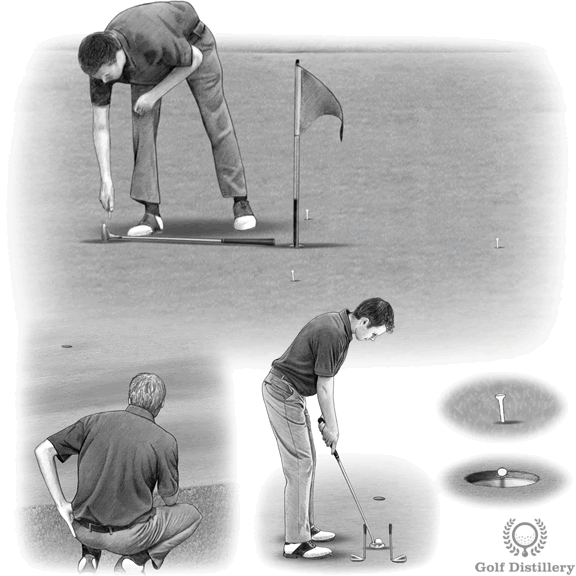Join Our Senior Golfers Newsletter!
Sign up today and receive your free Golf After 60 Bonus Stretch Guide!
When it comes to golf, one area of the game that is often overlooked but incredibly vital is the short game. The short game refers to the shots played around or near the green, including chip shots, pitch shots, and putting. While distance and power off the tee may grab attention, it is the finesse and precision of the short game that truly separates good golfers from great ones. In this post, we will explore the importance of The Short Game, discuss ways to improve it, and highlight why understanding this aspect of golf is essential for scoring better.

Improving Your Short Game
The short game acts as a strong foundation for a golfer’s overall performance. Think of it as the glue that holds a round together. Regardless of how well you drive the ball off the tee, if you struggle around the greens, your scores will suffer. The short game contributes significantly to scoring, as it allows you to recover from difficult situations, save strokes, and convert opportunities. It is the secret weapon that enables professionals to consistently shoot low scores and win championships.
Improving the short game requires a combination of technique, touch, and mental fortitude. Firstly, one must develop solid mechanics for various shots. This includes understanding proper setup, alignment, grip, and swing mechanics specific to chips, pitches, and putts. Consistency in executing these fundamentals is crucial. Practice and repetition are key, allowing muscle memory to develop and ingraining the necessary motions to execute shots instinctively.
Secondly, touch or feel is essential in the short game. It involves understanding the firmness of the ground, the height and speed of shots, and the ability to control distances accurately. This comes with experience and practice, developing a sense of touch through trial and error. Spending time hitting a variety of shots from different lies, slopes, and distances will help golfers develop the necessary touch required to judge and execute shots effectively.

Lastly, the short game requires mental fortitude. Nerves and pressures can impact one’s ability to execute shots precisely. Remaining calm, focused, and confident is crucial. Visualizing shots, assessing the situation, and committing to the chosen shot are vital mental skills that can make a significant difference. Practicing mindfulness, breathing exercises, and pre-shot routines can help manage mental challenges and enhance performance in the short game.
Understanding the short game from a strategic perspective is equally important. It involves assessing the lie, green contours, and pin position to make informed decisions on shot selection. Golfers need to evaluate the risk-reward scenarios, considering potential hazards and the likelihood of executing certain shots successfully. Often, taking a safer route and aiming for conservative targets can lead to better results. This strategic awareness, combined with a strong technical foundation, allows golfers to make smart decisions and maximize their scoring potential.
Scoring better in golf relies heavily on the short game. The majority of shots in a round occur around the greens, making it an area with tremendous scoring potential. Being adept at chip shots allows you to get the ball close to the hole, setting up realistic birdie opportunities. Mastering pitch shots gives you the ability to hit high, soft shots that stop quickly, ideal for attacking tucked pins. And, of course, putting proficiency is vital for converting chances and avoiding three-putts.
Here are some tips on how to master the short game:


Here are some additional tips that may be helpful:
In conclusion, the short game is not to be neglected or underestimated in golf. It is a fundamental aspect of the game that directly impacts scoring. Improving the short game requires technical proficiency, touch, and mental resilience. Understanding the strategic elements of the short game allows golfers to make intelligent decisions and maximize their chances of scoring better. By focusing on these essential aspects, golfers can elevate their overall performance, lower their scores, and experience the satisfaction of mastering a crucial element of the game. So, commit time and effort to developing your short game, and watch your scores improve.

No matter how good you are at golf you will likely putt upwards of thirty times per round. Certainly, scratch golfers will finish their rounds with fewer putts than bogey golfers but putting still accounts for a most significant part of the game. As such, putting should be a prime focus of attention for every golfer as improvements there can directly lead to lower scorecards.

This drill will help you practice putting from three key distances while at the same time training you to hit putts from all sorts of breaks (left-to-right, right-to-left, downhill, uphill).
Follow these steps in order to perform this putting drill:
This drill trains you to try and make putts from the ‘money’ range, i.e., from a distance where it can make a real difference to your scorecard or match.
Certainly, your one putter-length putts will be easier to make than those from three putter-lengths but practicing them all will train you to go for it whenever you are within that distance to the hole.
Additionally, while the shorter putts can be given to you from time to time in casual games it is crucial that you practice hitting them for the situations or matches where they will not.
The drill is also beneficial in that you will practice hitting from all around the hole and not just from one line. Indeed, putting from a flat surface is fine for improving your putting stroke and putting distance control but less so for hitting putts that break left or right, or are slightly downhill or uphill.
This drill will make sure that you become as comfortable hitting putts that go left-to-right than with those that go right-to-left.

Every putting stroke – especially for longer putts – feature at least a little bit of a natural arc. What this means is that the clubhead of the putter doesn’t move in a perfectly straight line going back and through the ball. Rather, the clubhead will move a little inside both in the putt’s backswing and in its follow through. This is normal because your hands are attached to your body with one arm on each side.
There are instances however where you might want to favor a straighter putting stroke. Follow the instructions below in order to get rid of the arc in your putting stroke if it is proving problematic.
A straight back and through putting stroke can be more reliable and consistent than one that features a lot of arc.
Indeed, a putter head that is kept straight and square going back has better odds of being square at the impact position. This is in contrast to an arc-y putting stroke where the putter head is in an open position in the backswing. Bringing that open clubface back to square requires an additional level of precision.
Instead, mistiming issues can result in an open or a closed clubhead and ultimately in pushed or pulled putts.
A straight putting stroke can be especially crucial and work best for smaller putts. Indeed, smaller putts require the fewest distance travelled by the putter. As such, the natural arc is less of a factor and it should be easiest to hit a straight back and through putt with these shorter putts.
Harvey Penick used to say that golfers should take dead aim. While he may have been talking about golf shots using longer clubs and full swings that saying can certainly also apply to putting.
Indeed, rather than aiming at the general direction of the hole it can be quite useful to aim at the very center of the hole. That way, missing that very precise target can still result in holed putts.
Follow these steps in order to make a precise target in the middle of the hole:
If you want to make sure not to damage the inside of the cup as prescribed or if there is a hard plastic liner preventing you from doing so there is an easy alternative.
Indeed, practice your putting as you normally would on the putting green but instead of aiming at the holes simply aim at a tee (or tees) that you previously inserted into the ground. Imagine that you must hit the tee in order for the putt to count as made. Any putt that missed the tee can be deemed not to fall in.




